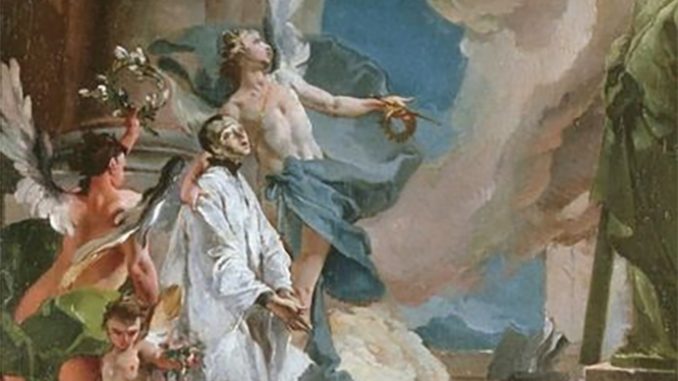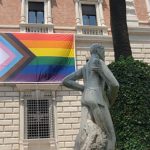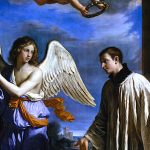
Can a twenty-first-century teen learn anything about dealing with anger, lust, or greed from a child of the sixteenth century? Might a modern young adult better understand how to show respect for imperfect parents from a privileged son of the nobility?
Through Saint Aloysius Gonzaga, yes, they can.
Saint Aloysius Gonzaga (1568-1591) was the oldest child and heir of Ferrante Gonzaga, the Marquis of Castiglione, and Donna Marta, the Countess of Tana di Santena. His father was a courtier to King Philip II of Spain, Portugal, Naples, and Sicily, as well as a soldier. Aloysius’ mother was a gentle, pious woman who had served as a maid of honor to Philip’s wife, Queen Elisabeth of Valois.
When Ferrante was ordered to take command of three thousand Italian infantrymen, he decided it was time for his son to experience military life. Aloysius was four years old. The little boy loved the noise and pageantry of camp life and had his own helmet, coat of mail, and little rapier. It’s not clear whether his mother ever learned that gunpowder burned his face while he was playing with a musket on one occasion or that he snuck off and intentionally discharged a cannon. The recoil should have killed him.
But Donna Marta certainly learned about the vocabulary that her son picked up from soldiers after he returned from the military camp. When the pious boy was told that he had learned to swear and blaspheme—although he was too young for this to be truly sinful—he was ashamed and resolved never to speak that way again.
Young Aloysius was also ashamed of his explosive outbursts of anger, known as a Gonzaga family trait. Although he was spiritually sensitive and notably devout as a child, that didn’t keep him from occasionally losing his temper. But he saw that weakness as a personal fault to be conquered, not a character trait to be accepted or an insignificant matter to be ignored.
At one point, his father ordered Aloysius and his younger brother to serve as pages in the king’s court. The two teenagers obediently accompanied James, the son and heir of King Philip. They were also educated alongside the young prince, so Aloysius received an excellent education in both secular and sacred matters. He learned to speak several languages and was a gifted student in mathematics and philosophy. He volunteered to teach the catechism to poor children.
Aloysius had developed a form of malaria when he was very young and was bedridden for a time. Later, he suffered from a recurrent kidney problem, and there were many times during his life when he was dangerously ill. He learned to be patient with these setbacks and spent much of that time in prayer.
However, the pious teenager also imposed serious physical penances upon himself. He fasted often, sometimes to gain an indulgence or for the sake of an end to political disturbances at the time. He denied himself sleep so that he could spend more time in prayer. He refused to allow a fire to be lit in his bedroom at night as a penance. These penances probably contributed to his illnesses and perhaps even shortened his life. However, he was always obedient when doctors (or later, his Jesuit superiors) ordered him to limit these practices.
Two of Aloysius’ most well-known penances seem odd to our modern world.
The first was his practice of “custody of the eyes.” Some biographers claim that, out of his desire to avoid the sin of lust, he never raised his eyes from the ground, not even to look at his own mother. Since he was very close to his mother, that is probably an exaggeration. However, a devout teenage boy concerned about the virtue of purity likely make a habit of not staring or even looking too closely at the extravagantly and immodestly dressed women of the Spanish court.
His other notable penance was self-flagellation. While this is rarely practiced today and while there are certainly some who have disciplined their bodies for the wrong reasons—such as despair or mental illness—it has been commonly practiced for centuries by many saints. This physical penance is performed for the sake of self-mastery, not out of self-hatred. As Saint Paul explained it:
Every athlete exercises self-control in all things. They do it to receive a perishable wreath, but we an imperishable. Well, I do not run aimlessly, I do not box as one beating the air; but I pommel my body and subdue it, lest after preaching to others I myself should be disqualified.
But the holiness of saints is not driven by their penances. It is the love of God that directs their lives, and the penances follow.
Aloysius’ companions and teachers noticed that he carefully prepared himself—praying and going to Confession—each time before he received Communion (receiving Communion, of course, was not a daily occurrence for laity in the sixteenth century). They also saw that he was very attentive at Mass and sometimes even moved to tears, a rare behavior for teenage boys in any century.
Unfortunately, Aloysius seems to have responded to every normal childhood temptation with such dedication that he can seem, well, a bit too perfect. That’s why it’s important to understand the challenges he faced as the son of a marquis.
It was always assumed that Aloysius would grow up and inherit his father’s title and wealth, marry into the nobility, serve at court, and lead military campaigns. But Aloysius constantly struggled with poor health, cared nothing for material wealth, hated it when people fawned over him, and, of course, discerned that God was calling him to religious life. Although he was clearly not suited to the role of heir to a powerful noble house, his father refused to recognize the truth about his son.
When young Aloysius told his father that he wanted to become a religious, Ferrante exploded. A bitter family battle lasted for years. It is important to note that Aloysius always obeyed and showed respect for his father, despite Ferrante’s threats, promises, and endless outbursts of anger. Other members of the family also tried to convince Aloysius to give up. Almost no one—except his mother—could understand how a young man could want to turn his back on such power and wealth and instead become a Jesuit priest.
Ferrante, of course, had a very practical reason to want Aloysius to remain his heir. Aloysius was an excellent peacemaker. When Aloysius’ brother and a relative got into a violent fight over the rights to a piece of property, it was Aloysius who single-handedly negotiated an end to a months-long disagreement through one amicable meeting. And Ferrante, who had a gambling addiction and therefore had significant debts, appreciated Aloysius’s success in tactfully placating his father’s numerous creditors.
By the time Ferrante gave in and allowed Aloysius to formally give up his rights as heir to his younger brother, Aloysius was wise and holy beyond his years. His Jesuit superiors, recognizing that his vocation had been tested in ways far more difficult than anything they could do, shortened the length of his novitiate.
Although Aloysius’ poor health continued after he entered the Jesuits, he was strong enough to help the sick during an outbreak of illness in the area. But the effort drained him, and he became seriously ill soon afterward. Those who witnessed the peaceful, holy death of the twenty-three-year-old immediately called him a saint.
Soon afterward, Aloysius sent proofs of that from heaven.
Before agreeing to allow Aloysius to renounce his title, Ferrante gave his son his blessing and told him that he loved him. After Aloysius entered the Jesuits, Ferrante gave up his longstanding gambling addiction and began to pray. He died of gout while Aloysius was still alive, but he tried to emulate his son’s example of holiness.
Two years after Aloysius’ death, the Gonzaga castle was attacked. Robbers shot one of Aloysius’ brothers to death and stabbed his mother multiple times. When Donna Marta’s body was found, it was assumed she would die very soon. With her family gathered around her for what they thought would be her final moments, Donna Marta suddenly smiled and got up from bed, completely cured. She said she had seen Aloysius in heaven.
In the years following, numerous relatives and members of the Jesuit order reported visions and miracles as well, and the Vatican had fifteen attested cases from which to choose at the time of his canonization.
Picture-perfect statues and holy cards of Saint Aloysius can make him seem squeaky clean and unsympathetic to the problems of ordinary youth. But he struggled with a bad temper, was surrounded by temptations, and was misunderstood by those closest to him. Beneath the wealth and good looks was a young man with a pure heart who would not let anything deter him from doing God’s will.
And that is an example that can help teens, young adults, and even some not-so-young adults today.
Endnotes:
If you value the news and views Catholic World Report provides, please consider donating to support our efforts. Your contribution will help us continue to make CWR available to all readers worldwide for free, without a subscription. Thank you for your generosity!
Click here for more information on donating to CWR. Click here to sign up for our newsletter.










